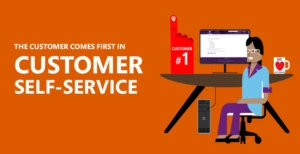
Self to Assisted Customer Service: 3 Ways to Effectively Pass the Baton
While many brands and organizations are stepping up (and keeping up) when it comes to multichannel customer service, it’s the transition across channels where service often stumbles, causing extra frustration for customers, even those who wanted to save time and effort by serving themselves.
For the first time in the history of Forrester Research’s North American Consumer Technographics Customer Life Cycle Survey, consumers now say they are using self-service FAQ pages on a company’s website for customer service more often than speaking with a live agent on the phone. According to the survey, self-service channel usage has increased from 67% in 2012 to 76% in 2014, while phone usage remains the same at 73%. These findings correspond with another recent survey from CEB that says 57.7% of customers will first visit a company's website to resolve their issues. And that’s terrific, except that 35.5% were on the company’s website when they called an agent.
Due to issue complexity or lack of information, online self-service cannot resolve every customer’s issue or question. In the move from self to assisted service is where we need to look at reducing a customer’s effort and creating a smoother baton pass to agent support. Right now, many self-service portals aren’t effectively passing that baton. Instead, they’re creating or escalating customer frustrations, causing friction between the customer and the agent right from the start.
In a self to assisted service escalation, give your agents the best opportunity to start and end on a positive note. Here are three key ways to set your customers and your agents up for self to assisted success:
- Make it easy to make contact. Some brands and organizations make their online customer self-service offering an island to itself, but the best build bridges between service channels. Make sure your self-service site includes one or more assisted service options such as support ticketing, a customer service email address, a support number and/or live chat.
Live chat pairs especially well with online self-service as it allows the customer to stay on the same platform and many times multitask during the interaction with the agent, saving the customer time. In numerous surveys, chat has received high marks for customer satisfaction. (Read 5 Reasons It’s Time to Chat with Your Customers)
- Give customers the information they want. Make your customer service content easily searchable and when possible, do not gate it. Organize your service content by most-viewed and recently-added, as well as add a featured content section for trending issues or popular topics.
If customers can’t find the self-service information they’re looking for, or information is dated, requires a log-in or is incomplete, the customer’s self-service frustrations will carry over and be conveyed to the assisted service agent in addition to the original issue or question.
- Give agents the information they need. When a customer makes contact with an agent, that customer may have already looked through ten knowledgebase articles, tried to submit a support ticket and filled in a feedback request. Empower your agents with as much real-time above the queue customer insights as possible, so that an already frustrated customer doesn’t become more so by being asked to repeat the actions they’ve already taken.
The same CEB research cited above found that when customer effort is made or kept low, 94% of consumers will make additional purchases from that brand and 81% will spread positive word of mouth about the company. Conversely, when customer effort is high, 96% say they will look for another brand to do business with.
When self-service doesn’t yield the answer your customer was looking for, make sure it still assists your customers in achieving a positive, effective and efficient result.
——————
Watch the Webinar: Self-Service Success
Give Customers the Answers they Need
When it comes to service and support, customers don’t long for conversation. They want answers at their convenience, 24 hours a day, 7 days a week, which emphasizes the need for greater and better self-service options to help drive:
• First Contact Resolution
• Employee Engagement
• Consistency of Information Across Channels
• Self-Service Deflection from High-Cost Channels
• And Greater Customer Satisfaction.
In a pre-recorded webinar, The Service Council’s Chief Customer Officer and industry analyst Sumair Dutta details benefits and current statistics around self-service for customer service. Bill Patterson, Microsoft Senior Director of Customer Self-service Solutions explores the critical role of knowledge and portals in self-service efforts, as well as consistent engagement across channels.
nTelos Wireless Information Technology Project Manager Peter Friedenberg also joins the conversation to share the brand’s notable self-service success, along with best practices to drive self-service adoption and continued use. Don’t miss out on learning just how much an effective self-service offering can quickly improve your brand or organization’s customer service success. Watch this complimentary thought leadership and best practices webinar.




